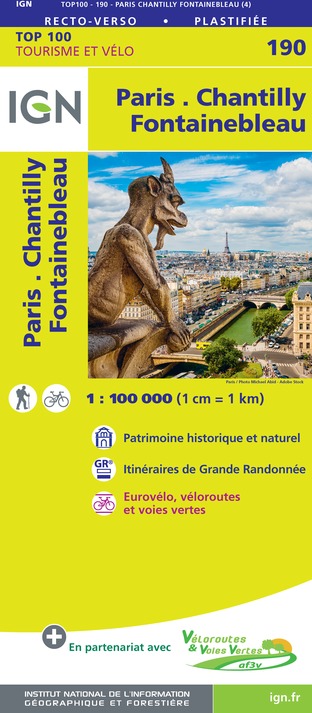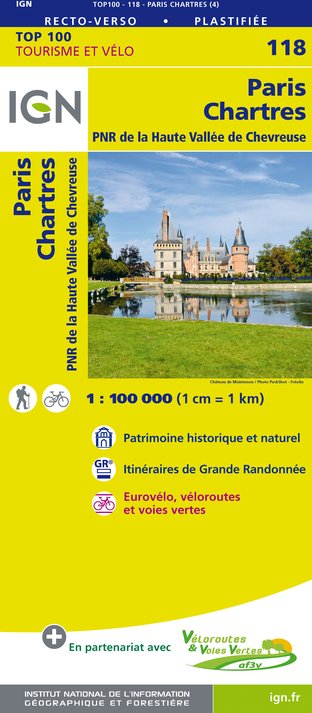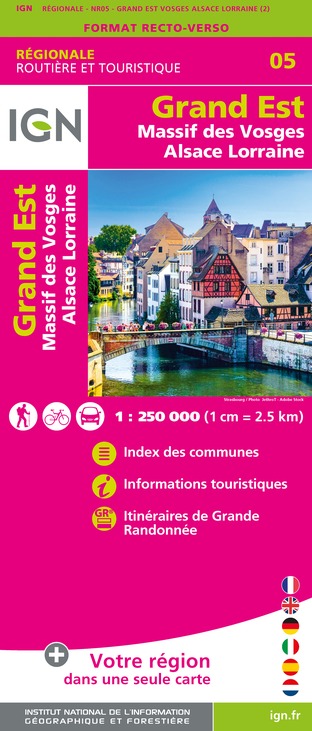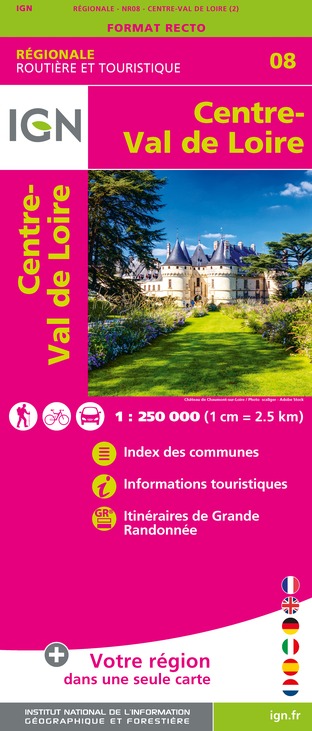Alerta
Alertas
Tipo de práctica
A pie
Muy fácil
1h
Presentación
Descripción
Mapa
Puntos de interés
Resumen de Cirkwi
Calificaciones y reseñas
Ver alrededor
Paseo por Moisenay


Crédito : CCBRC
El resumen de Cirkwi
Descubre Moisenay: Un recorrido por el patrimonio y la naturaleza
Imagina pasear por un pintoresco pueblo ubicado en el sereno Val d'Ancœur, junto al majestuoso Château de Vaux-le-Vicomte y en las proximidades de Blandy-les-Tours. Este es Moisenay, un pueblo que ha preservado brillantemente su esencia rural, ofreciendo la oportunidad de sumergirse en el corazón de un valle bucólico. Diseñado por la Communauté de Communes Brie des Rivières et Châteaux, este itinerario te invita a explorar el impresionante campo, puentes históricos, antiguos molinos y un rico patrimonio encapsulado en la arquitectura del siglo XII y XIII de la Église Saint-Martin. Una mezcla de grandeza histórica y belleza natural espera para inspirar tus sentidos.
Información esencial sobre el itinerario
Con una distancia de 3.3 kilómetros y una elevación modesta que va desde los 53 a los 86 metros, esta caminata es accesible para entusiastas de todos los niveles. Cabe destacar que la ruta comienza y termina en el estacionamiento del complejo deportivo, lo que garantiza comodidad para los visitantes. El camino atraviesa el pueblo, cruzando hitos históricos como el Moulin de Pouilly y el Pont de Fer, sin pendientes pronunciadas, lo que lo convierte en una elección ideal para una exploración tranquila. No está marcado, por lo que se recomienda a los aventureros llevar un mapa o utilizar dispositivos de navegación digital para una experiencia sin problemas.
Consejos estacionales para los exploradores
Sin importar la estación del año, Moisenay ofrece una experiencia cautivadora. La primavera y el otoño, con su clima suave, son perfectos para apreciar la flora floreciente y los tonos dorados y nítidos de las hojas. En verano, la sombra proporcionada por los altos árboles ofrece un respiro del calor, convirtiéndolo en el momento ideal para los buscadores de ocio. Sin embargo, como el sendero incluye campos y bosques, es necesario usar calzado adecuado durante todo el año para transitar cómodamente por el terreno. Siempre verifica el pronóstico del tiempo con anticipación para evitar condiciones inesperadas y asegurar una visita encantadora.
Moisenay: Una joya cultural e histórica
Moisenay, ubicado en la región de Île-de-France, es un testamento del patrimonio rural e histórico francés. Desde sus cimientos, ha sido testigo de siglos de evolución cultural, con la Église Saint-Martin simbolizando la destreza arquitectónica y la vida espiritual de la Edad Media en Seine-et-Marne. Este pueblo, situado cerca de sitios históricos clave como el Château de Vaux-le-Vicomte, funciona como un museo vivo, invitando a los exploradores a retroceder en el tiempo y experimentar el rico tejido de la cultura del campo francés, su gente y su conexión con la tierra.
Guía del clima para los visitantes de Moisenay
Disfrutando de un clima templado, Moisenay cuenta con estaciones distintas, cada una ofreciendo encantos únicos para los visitantes. El clima de la región suele ser suave, con veranos cálidos e inviernos frescos, lo que convierte a la primavera y el otoño en las épocas ideales para las actividades al aire libre. Para aprovechar al máximo los paisajes verdes y los sitios históricos, se recomienda visitar entre abril y octubre. Durante estos meses, las condiciones climáticas son más propicias para caminar, asegurando una aventura al aire libre cómoda y enriquecedora en Moisenay.
Imagina pasear por un pintoresco pueblo ubicado en el sereno Val d'Ancœur, junto al majestuoso Château de Vaux-le-Vicomte y en las proximidades de Blandy-les-Tours. Este es Moisenay, un pueblo que ha preservado brillantemente su esencia rural, ofreciendo la oportunidad de sumergirse en el corazón de un valle bucólico. Diseñado por la Communauté de Communes Brie des Rivières et Châteaux, este itinerario te invita a explorar el impresionante campo, puentes históricos, antiguos molinos y un rico patrimonio encapsulado en la arquitectura del siglo XII y XIII de la Église Saint-Martin. Una mezcla de grandeza histórica y belleza natural espera para inspirar tus sentidos.
Información esencial sobre el itinerario
Con una distancia de 3.3 kilómetros y una elevación modesta que va desde los 53 a los 86 metros, esta caminata es accesible para entusiastas de todos los niveles. Cabe destacar que la ruta comienza y termina en el estacionamiento del complejo deportivo, lo que garantiza comodidad para los visitantes. El camino atraviesa el pueblo, cruzando hitos históricos como el Moulin de Pouilly y el Pont de Fer, sin pendientes pronunciadas, lo que lo convierte en una elección ideal para una exploración tranquila. No está marcado, por lo que se recomienda a los aventureros llevar un mapa o utilizar dispositivos de navegación digital para una experiencia sin problemas.
Consejos estacionales para los exploradores
Sin importar la estación del año, Moisenay ofrece una experiencia cautivadora. La primavera y el otoño, con su clima suave, son perfectos para apreciar la flora floreciente y los tonos dorados y nítidos de las hojas. En verano, la sombra proporcionada por los altos árboles ofrece un respiro del calor, convirtiéndolo en el momento ideal para los buscadores de ocio. Sin embargo, como el sendero incluye campos y bosques, es necesario usar calzado adecuado durante todo el año para transitar cómodamente por el terreno. Siempre verifica el pronóstico del tiempo con anticipación para evitar condiciones inesperadas y asegurar una visita encantadora.
Moisenay: Una joya cultural e histórica
Moisenay, ubicado en la región de Île-de-France, es un testamento del patrimonio rural e histórico francés. Desde sus cimientos, ha sido testigo de siglos de evolución cultural, con la Église Saint-Martin simbolizando la destreza arquitectónica y la vida espiritual de la Edad Media en Seine-et-Marne. Este pueblo, situado cerca de sitios históricos clave como el Château de Vaux-le-Vicomte, funciona como un museo vivo, invitando a los exploradores a retroceder en el tiempo y experimentar el rico tejido de la cultura del campo francés, su gente y su conexión con la tierra.
Guía del clima para los visitantes de Moisenay
Disfrutando de un clima templado, Moisenay cuenta con estaciones distintas, cada una ofreciendo encantos únicos para los visitantes. El clima de la región suele ser suave, con veranos cálidos e inviernos frescos, lo que convierte a la primavera y el otoño en las épocas ideales para las actividades al aire libre. Para aprovechar al máximo los paisajes verdes y los sitios históricos, se recomienda visitar entre abril y octubre. Durante estos meses, las condiciones climáticas son más propicias para caminar, asegurando una aventura al aire libre cómoda y enriquecedora en Moisenay.
Generado automáticamente.
IGN tarjetas

2416SB - MELUN MORMANT
Editora : IGN
Recopilación : TOP 25 ET SÉRIE BLEUE
Escalera : 1:25 000
13.90€

190 PARIS CHANTILLY FONTAINEBLEAU
Editora : IGN
Recopilación : TOP 100
Escalera : 1:100 000
8.40€

118 PARIS CHARTRES PNR DE LA HAUTE VALLÉE DE CHEVREUSE
Editora : IGN
Recopilación : TOP 100
Escalera : 1:100 000
8.40€

119 PARIS SENS PNR DU GÂTINAIS FRANÇAIS
Editora : IGN
Recopilación : TOP 100
Escalera : 1:100 000
8.40€

D75-95 ÎLE-DE-FRANCE OUEST
Editora : IGN
Recopilación : CARTES DÉPARTEMENTALES IGN
Escalera : 1:150 000
5.90€

D77 SEINE-ET-MARNE
Editora : IGN
Recopilación : CARTES DÉPARTEMENTALES IGN
Escalera : 1:150 000
5.90€

NR05 GRAND EST RECTO/VERSO MASSIF DES VOSGES ALSACE LORRAINE
Editora : IGN
Recopilación : CARTES RÉGIONALES IGN
Escalera : 1:250 000
6.80€

NR04 - GRAND EST RECTO/VERSO ARDENNE CHAMPAGNE
Editora : IGN
Recopilación : CARTES RÉGIONALES IGN
Escalera : 1:250 000
6.80€

NR03 ÍLE DE FRANCE
Editora : IGN
Recopilación : CARTES RÉGIONALES IGN
Escalera : 1:250 000
6.80€

NR08 CENTRE-VAL DE LOIRE
Editora : IGN
Recopilación : CARTES RÉGIONALES IGN
Escalera : 1:250 000
6.80€

EUROPE
Editora : IGN
Recopilación : DÉCOUVERTE DES PAYS DU MONDE IGN
Escalera : 1:2 500 000
7.00€
Informaciónes técnicas
A pie
Dificultad
Muy fácil
Duración
1h
Dist.
3.3 km
Tipo de práctica
A pie
Muy fácil
1h
Mostrar más
Perfil altimétrico
Punto de partida
7
Parking du complexe sportif - rue de la Grange
,
77950
Moisenay
Lat : 48.562491Lng : 2.733473
Puntos de interés
Autor de los datos
Calificaciones y reseñas
Para ver alrededor





